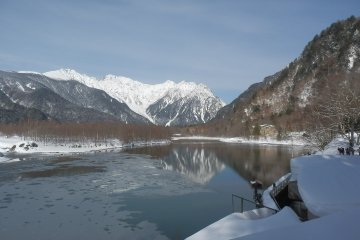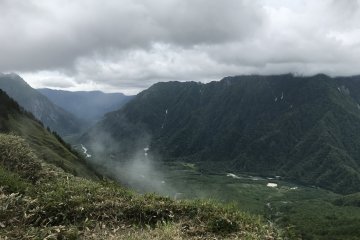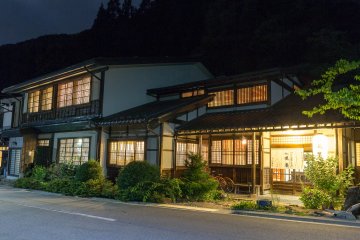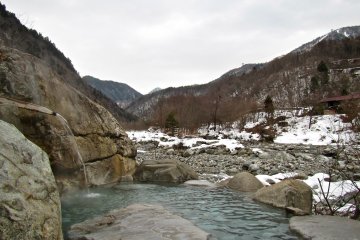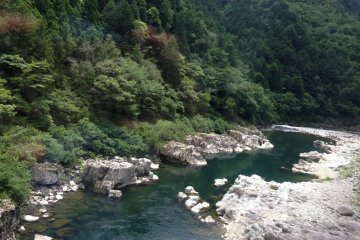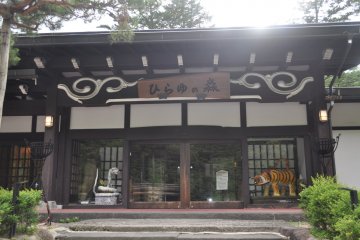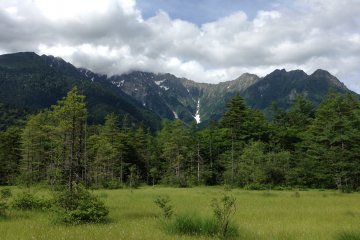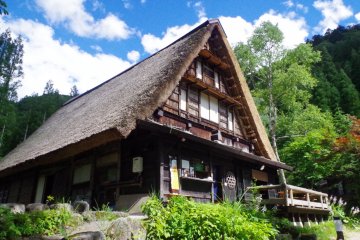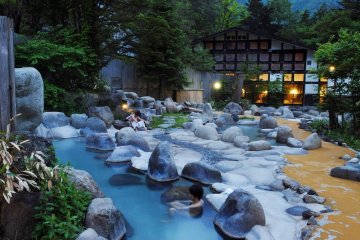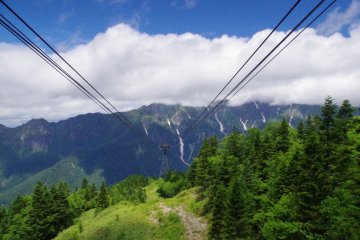The Wide View Hida cuts through a deep green cleft as it enters and travels through Gifu Prefecture, rolling along a high handsome train trestle erected over a cool rushing river lined with great slabs of striated stone. The water foams blue and white on the boulders, with fisherfolk in waders and wide brimmed hats dotting the shallows. The train rolls past a rickety outbuilding framed with a profusion of wildflowers, a cat lounging in the sun among them. The hills roll by in emerald hues as we approach the charming mountain city of Takayama (the name of which translates to “tall mountain”).
It is in the outer reaches of Takayama that the Okuhida Hot Springs area is found. The area is the host to several hot springs resorts, including the hot springs hamlet of Hirayu Onsen. This pretty little town has skiing in the winter, hiking and mountain climbing in the gentler seasons, refreshing breezes in the summer with a flock of sheep to keep the slopes neatly maintained, and rejuvenating natural hot springs all year round.
Hirayu Onsen offers a number of attractions that can easily occupy a half day’s walking tour, either guided or solo. Hirayu Otaki, a 64 meter waterfall born from the dormant volcano Mt. Noritake, churns with mist and spray before flowing into Hirayu River. On the nearby Hirayu Nature Exploration Road, hikers can move through a serene beech forest (but solo hikers may want to bring a bear bell, as they are occasionally known to visit the area). At the Hirayu Minzoku-kan, a traditional gassho-zukuri style building with a steeply peaked roof covered in reed thatch, walkers can stop for refreshment in the old-fashioned cafe, soaking up cool breezes on the terrace in the summer or gathering warmth around the irori (sunken fire pit in the common room) in the winter. Next door, an on-your-honor public hot springs bath asks that you drop 300 yen in the box before using the facility. Finally, try an onsen hantai tamago(soft-boiled egg cooked by immersion in hot spring water) at a shop in town.
Early risers (or those who might be convinced to get up early once in awhile) will enjoy the sunrise from Mt. Norikura. Departing Hirayu Onsen before four a.m., sun worshippers should dress warmly, including weatherproof outer ware, even in summer, as the hike to the viewpoint may prove to be quite cold, even when temperatures below soar. The effort it worth it, though, when the sun finally peeks over the lip of the Northern Alps and breaks through the clouds, flooding the landscape with glorious reds and oranges.
To get a different view of the mountains, the Shinhotaka Ropeway soars to 2,156 meters in a double decker gondola, depositing sightseers among the clouds in the Hotaka Mountains. With breathtaking views from Nishihotakaguchi Station, visitors can enjoy a 360 degree look at the surrounding peaks, such as Mt. Okuhotakadaka at 3,190 meters, Mt. Karasawadake at 3m110 meters, and Mt. Kitahotakadaka at 3m106 meters, the clouds overhead throwing deeper green shadows on the thickly wooded mountainside. Walking around at the top will reveal firs, white birch, Oezo willows, and the birdsong of bush warblers, spotted nutcrackers, and rock ptarmigans.
At the end of an active day, the best reward here is a soak in the hot springs at Hirayu. Fortified with natorium, calcium, magnesium, and aluminum, to name a few, a mineral soak in the outdoor pools constructed of rocks and trees soothes sore muscles and softens the skin.
Full disclosure: accommodation and tours were provided by Hirayu no Mori.
Half day walking tours of Hirayu Onsen can be arranged through Hirayu no Mori, and cost 2,500 yen, which includes admission to the sites, a guide, and access to Hirayu no Mori’s hot springs.
Admission on the Shinohtaka Ropeway (numbers 1 and 2) costs 2,900 yen for a round-trip ticket, and runs from about 9 a.m. to 5 p.m., depending on the season.



